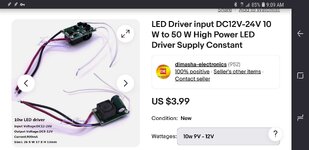LEDAdd1ct
Flashlight Enthusiast
Greetings, Fellow Fans of Photons!
I have a few questions/thoughts/considerations about both the efficiency of DC ➡ AC inverters as well as the most efficient 120V light bulb.
1) I plan to acquire a high capacity 12V LiFePO4 battery.
2) I plan to acquire the most efficient/reliable 100W equivalent 1600 lumens LED light bulb.
a) I have intensely researched 12V bulb options, and the only models I can find out there are poorly reviewed with suspect build quality
b) Additionally, while there is certainly an efficiency penalty to converting 12V DC to 120V AC, it would provide the greatest degree of flexibility in being able to swap out bulbs
3) Does anyone have a recommendation for the "most" efficient 120V 1600 lumen LED light bulb?
a) The best that I can find is the IKEA Solhetta, which is rated at
2700K
10.5W
1600 lumens
4) Can anyone provide information about the efficiency costs for a 50W, 100W, and 150W...DC ➡ AC inverter...with especial respect paid to this bulb, i.e., a 10W to 25W draw?
5) I would prefer an inverter "Made in U.S.A." if possible, but barring that, something from a name brand, established company would be ideal.
6) Does anyone know of a more efficient way to get 1600–2000 lumens in this format, i.e., a very high efficacy 12V fixture?
a) I can't find anything more efficient than the 10.5W IKEA bulb
b) Staying with 12V DC and cutting out the inverter...would be nice
Thank you!
I have a few questions/thoughts/considerations about both the efficiency of DC ➡ AC inverters as well as the most efficient 120V light bulb.
1) I plan to acquire a high capacity 12V LiFePO4 battery.
2) I plan to acquire the most efficient/reliable 100W equivalent 1600 lumens LED light bulb.
a) I have intensely researched 12V bulb options, and the only models I can find out there are poorly reviewed with suspect build quality
b) Additionally, while there is certainly an efficiency penalty to converting 12V DC to 120V AC, it would provide the greatest degree of flexibility in being able to swap out bulbs
3) Does anyone have a recommendation for the "most" efficient 120V 1600 lumen LED light bulb?
a) The best that I can find is the IKEA Solhetta, which is rated at
2700K
10.5W
1600 lumens
4) Can anyone provide information about the efficiency costs for a 50W, 100W, and 150W...DC ➡ AC inverter...with especial respect paid to this bulb, i.e., a 10W to 25W draw?
5) I would prefer an inverter "Made in U.S.A." if possible, but barring that, something from a name brand, established company would be ideal.
6) Does anyone know of a more efficient way to get 1600–2000 lumens in this format, i.e., a very high efficacy 12V fixture?
a) I can't find anything more efficient than the 10.5W IKEA bulb
b) Staying with 12V DC and cutting out the inverter...would be nice
Thank you!


